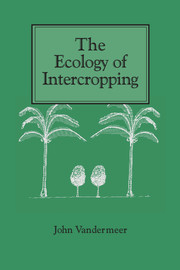Book contents
- Frontmatter
- Contents
- Preface
- 1 Introduction: intercrops and ecology
- 2 The measurement of intercrop performance
- 3 The competitive production principle
- 4 Facilitation
- 5 Mechanisms of the competitive production principle
- 6 The environments modified to produce facilitation
- 7 Special problems in intercrops involving perennials
- 8 Weeds and intercrops
- 9 Variability and intercrops
- 10 Planning intercrops – a phenomenological approach
- 11 Planning intercrops – a mechanistic approach
- 12 Critical research directions for the future
- References
- Author index
- Subject index
- Frontmatter
- Contents
- Preface
- 1 Introduction: intercrops and ecology
- 2 The measurement of intercrop performance
- 3 The competitive production principle
- 4 Facilitation
- 5 Mechanisms of the competitive production principle
- 6 The environments modified to produce facilitation
- 7 Special problems in intercrops involving perennials
- 8 Weeds and intercrops
- 9 Variability and intercrops
- 10 Planning intercrops – a phenomenological approach
- 11 Planning intercrops – a mechanistic approach
- 12 Critical research directions for the future
- References
- Author index
- Subject index
Summary
Figure 4.1 shows a peculiar intercropping system in central Nicaragua. The trees are jocotes (a fresh fruit, Spondias purpurea) and the epiphytic cactus growing on their trunks is pitahaya (Hylocereus sp.) whose fruit is used to make a drink. At first glance we might think of this as a trivial case of the competitive production principle since neither species would seem to have much of an effect on the other and competition should be quite low.
But a more important, if obvious, observation is to be made here. The pitahaya is an epiphyte and does not grow well on the ground. Thus, the jocote brings something to the environment which benefits the pitahaya – its trunk. The jocote ‘modifies’ the environment in a positive way for the other species, and thus presents us with a simple and obvious case of facilitation.
The basic idea
This principle is presented as complementary to the competitive production principle, to account for the many cases known both in agricultural (e.g. Vandermeer et al., 1983; Singh et al., 1986; Nair et al., 1979; Osman & Osman, 1982) and in non-agricultural systems (Vandermeer, 1980b: Vandermeer et al., 1985; Rathcke, 1984; Hazlett, 1983; Room, 1972) in which one species provides some sort of benefit for another species. Probably there will be particular mechanisms which will not amenably fit into either category, but for the most part it is not difficult to put particular mechanisms in one or the other of these two categories.
- Type
- Chapter
- Information
- The Ecology of Intercropping , pp. 46 - 67Publisher: Cambridge University PressPrint publication year: 1989



